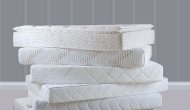Have you ever wondered what makes your mattress so comfortable? Or why some beds feel just right while others don't? It's not just about having a place to sleep; it's about understanding the hidden world inside your mattress.
When it comes to getting a good night's sleep, one often-overlooked factor is the understanding of mattress materials. Since we spend a significant portion of our lives in bed, we should know that the materials in our mattresses have impact on the quality of our sleep.
From the layers that conform to your body to the components that ensure long-term support, we're taking a closer look at what lies beneath your sheets.
Here we will investigate the fascinating world that makes up the components of a mattress, exploring their unique properties, benefits, and how they can make a difference in your sleep experience. So, let's embark on a journey through the realm of comfort, support, and the science behind our nights.
What's Inside Your Mattress
- Understanding the Anatomy of a Mattress
- The Comfort Layer: Your Key to a Restful Night
- The Transition Layer: Bridging Comfort and Support
- The Support Layer: The Backbone of Your Mattress
- Different Mattress Types
- What Mattress Materials to Avoid
FAQ
Understanding the Anatomy of a Mattress

Before we look into the types of mattress materials, it's important to understand the basic structure of a mattress. Let's peel back the covers and take a closer look at the anatomy of a mattress.
Most mattresses are built using three core layers:
- The Comfort Layer
- The Transition Layer
- The Support Layer
Each layer plays a unique role and houses different contents and components, working together to create a perfect balance of comfort and support. Let's take a closer look at each one.
The Comfort Layer: Your Key to a Restful Night

The comfort layer, as the name implies, is designed to maximize the comfort of your sleeping experience. This layer sits at the top of your mattress, making direct contact with your body. This layer is often made from soft, plush materials designed to offer a luxurious, cushioned sleeping surface.
Ticking and Quilting
The outermost layer of your mattress, known as ticking, is usually made from a blend of cotton or cotton-polyester. This layer is quilted to create a soft, durable, and breathable cover for your mattress. High-quality mattresses often use handcrafted quilting with natural materials like 100% cotton ticking for enhanced comfort.
Padding
Underneath the ticking, you'll find the padding. This layer can be made from various materials, including cotton, wool, or foam. Its role is to provide a soft surface that contours your body, relieving pressure points and enhancing comfort.
The Quilted Top: An Extra Layer of Comfort
In some mattresses, you'll find a quilted top layer, often called a pillow-top or Euro-top. This layer consists of extra padding, such as foam or fiberfill, stitched into the cover. It adds a plush and cushiony feel to the mattress, making it especially comfortable for those who prefer a softer sleeping surface.
The Transition Layer: Bridging Comfort and Support

Situated between the comfort and support layers, the transition layer serves as a buffer zone. This layer is made up of denser materials, offering extra padding and support. This layer is crucial in maintaining the mattress's overall structure, preventing you from sinking too far into the support layer.
Extra Padding and Support
The transition layer may contain medium-firm versions of latex, micro coils, or other materials that provide additional cushioning. Its role is to transition from the soft comfort layer to the firmer support layer, promoting proper spinal alignment.
The Support Layer: The Backbone of Your Mattress

The support layer, found at the base of the mattress, is the main contributor to its firmness. This layer provides the core support your body needs while you sleep, keeping your spine in alignment and distributing your weight evenly across the mattress.
Springs and Coils
The support layer typically contains steel coils or springs. These components act as the mattress's foundation, providing crucial support and durability. There are several types of coil systems, including open coil or 'Bonnell' system, pocket coil system, and continuous coil system.
Foam
In some mattresses, the support layer may contain foam instead of springs. High-density foam like reflex foam is a common choice because of it's durability and support. All-foam mattresses are often lighter and easier to move, making them a practical choice for many people.
The Edge Support: Keeping It Stable
Many modern mattresses come equipped with reinforced edge support. This is an essential feature, as it ensures that the edges of the mattress are stable and supportive. It helps prevent sagging and provides a larger usable sleeping surface.
Different Mattress Types

Now that we understand the basic layers of a mattress, let's discuss the specifics of different mattress types as their components will change depending on style. The materials used in these mattress types can significantly impact your sleep quality and comfort.
The Innerspring Mattress: A Classic Choice
The traditional innerspring mattress has a core of steel coil springs, providing robust support. The coils are either connected by a strong border wire or individually encased in fabric. The comfort layer in an innerspring mattress often contains natural fibers like cotton or wool, or man-made ones like polyester or polyurethane foam.
The Hybrid Mattress: A Blend of the Best
Hybrid mattresses combine the best of both worlds, offering the support of innerspring coils and the comfort of foam or latex. They are designed to provide superior support, minimize motion transfer, and contour to your body. Hybrid mattresses often feature a more elastic mattress cover to prevent interference with the softness and conformation from memory foam layers.
The Latex Mattress: Natural Comfort

Latex mattresses offer a naturally supportive and breathable core, made from the sap of rubber trees. Latex foam layers in these mattresses deliver superior comfort and pressure relief. Latex mattresses are also a great choice for allergy sufferers as they naturally repel dust, mold, and other household allergens.
The Memory Foam Mattress: Customized Contouring
Memory foam mattresses, typically made from viscoelastic polyurethane foam, are renowned for their exceptional pressure relief and body contouring. Memory foam responds to the weight and warmth of your body, providing excellent body conformance. They also help balance your body temperature and absorb movement, ensuring a peaceful and undisturbed sleep.
What Mattress Materials to Avoid

Unfortunately, not all mattresses are created equal, and the components used in their construction can significantly impact your comfort and health. To make an informed decision when shopping for a new bed, it's important to be aware of what to avoid. Let’s see what you should steer clear of when shopping and what to look for instead.
1. Polyurethane Foam:
Polyurethane foam is a synthetic material commonly found in cheaper mattresses. While it can provide initial comfort, it's essential to know that polyurethane foam can break down quickly, leading to sagging and reduced support over time. Furthermore, many polyurethane foams release volatile organic compounds (VOCs) that can be harmful to your health, causing respiratory issues and allergies.
What to look for instead: Opt for mattresses with high-density memory foam or natural latex foam, which are more durable and offer better support without the harmful chemicals.
2. Fire Retardant Chemicals:
To meet safety standards, many mattresses are treated with fire-retardant chemicals like polybrominated diphenyl ethers (PBDEs) or chlorinated tris. These chemicals can release toxic fumes when exposed to heat, posing health risks to you and your family.
What to look for instead: Seek mattresses that use alternative fire-resistant materials such as wool or rayon, which are naturally fire-resistant and free from harmful chemicals.
3. Chemical Adhesives:
Some mattresses use chemical adhesives to bond layers of foam or other materials together. These adhesives may release harmful toxins, including formaldehyde, into the air, affecting indoor air quality.
What to look for instead: Choose mattresses that utilize water-based or solvent-free adhesives, which are less likely to emit harmful substances.
4. Low-Quality Innerspring Coils:
Low-quality innerspring coils can lead to uncomfortable pressure points and sagging over time. These mattresses may not provide the support necessary for a good night's sleep.
What to look for instead: If you prefer innerspring mattresses, aim for those with high-quality, individually wrapped coils or pocketed coils. These provide better support, reduce motion transfer, and have a longer lifespan.
5. Non-Organic Fabrics:
Mattress covers made from non-organic fabrics may contain synthetic materials treated with chemicals and pesticides. These can irritate your skin and potentially disrupt your sleep.
What to look for instead: Look for mattresses with organic cotton or bamboo covers, which are breathable, hypoallergenic, and free from harmful chemicals.
Conclusion
The journey through the intricate world of mattress components reveals a fascinating blend of science, comfort, and health. Understanding the layers and materials that make up your mattress is more than just a quest for comfort; it's an investment in your well-being.
From the plush comfort layer that cradles you in softness to the supportive transition and base layers that maintain your body's alignment, each component plays a pivotal role in ensuring a restful night's sleep.
As you stand at the crossroads of choosing the right mattress, remember that it's not just about the immediate comfort. Consider the long-term effects of materials like high-density memory foam or natural latex over quick-fix solutions like polyurethane foam.
As you can see , components of a good mattress can be subjective. Your choice impacts not only the quality of your sleep but also your overall health and the environment. Consider buying high end brands like Stearns & Foster and Tempur-pedic to ensure that the highest quality materials are used.
Armed with this knowledge, you're now equipped to make a choice that resonates with your body's needs and environmental consciousness, ensuring nights of peaceful, rejuvenating sleep on the right side of the bed.
FAQ
Q: How do different types of mattress coils affect support and comfort?
A: The type of coils in a mattress can greatly affect support and comfort. Pocketed coils offer individualized support and provide better motion isolation, while Bonnell coils are more traditional and can be firmer. Continuous coils provide consistent support but may transfer more motion.
Q: Can the material of a mattress cover affect sleep quality?
A: Yes, the material of a mattress cover can affect sleep. Natural fabrics like organic cotton or bamboo are hypoallergenic and promote better air circulation, leading to a cooler and more comfortable sleep. Synthetic materials, on the other hand, might trap heat and cause discomfort, especially for hot sleepers.
Q: How does the density of memory foam in a mattress affect sleep?
A: The density of memory foam in a mattress plays a crucial role in comfort and support. Higher-density memory foam provides better body contouring, pressure relief, and durability, but it can also retain more heat. Lower-density memory foam (ideal for side sleepers) is softer and cooler but may not offer the same level of support and can wear out more quickly.
Q: Is a latex mattress better for people with allergies?
A: Yes, latex mattresses are often recommended for people with allergies. Natural latex is hypoallergenic, resistant to dust mites, mold, and mildew. It is also breathable, which helps reduce the buildup of allergens. However, those with latex allergies should avoid these mattresses.
Q: How important is edge support in a mattress?
A: Edge support is important for maximizing the usable surface of the mattress and preventing sagging or rolling off the edges. It is especially important for older individuals or those with mobility issues, as it provides stability when sitting on the edge of the bed.
Q: Can the weight of a sleeper affect the choice of mattress components?
A: Yes, the weight of a sleeper can influence the choice of mattress components. Heavier individuals may require a mattress with firmer support, such as high-density foams or robust coil systems, to ensure proper spinal alignment and comfort. Lighter individuals might prefer softer mattresses with more conforming materials.

TL;DR: Mattress Components: Building Blocks for Better Sleep
When it comes to the importance of understanding mattress components for better sleep, there are three core layers. The comfort layer for softness and pressure relief, the transition layer for additional cushioning and support, and the support layer for firmness and spinal alignment.
Avoid, like low-quality foam and harmful chemicals, emphasizing the impact of mattress materials on health and sleep quality. Key considerations include the type of coils, mattress cover material, foam density, and edge support, tailored to individual needs and preferences.










